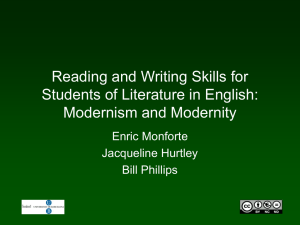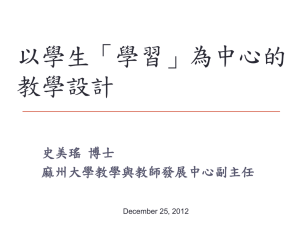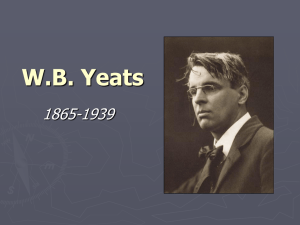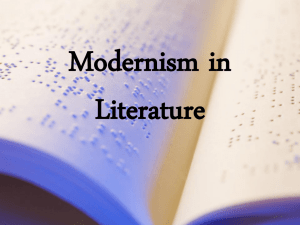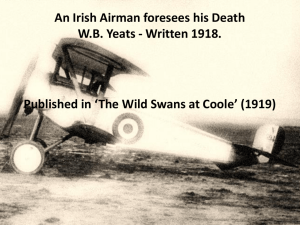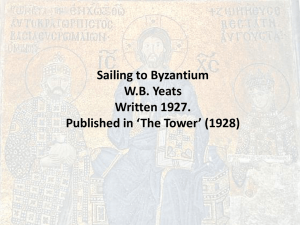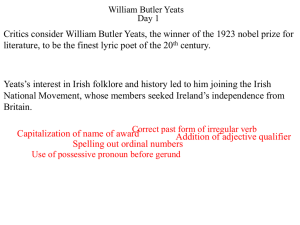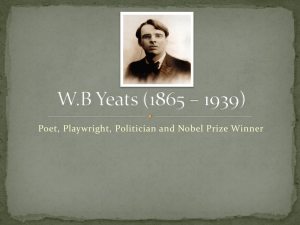- Bridgewater College WordPress
advertisement
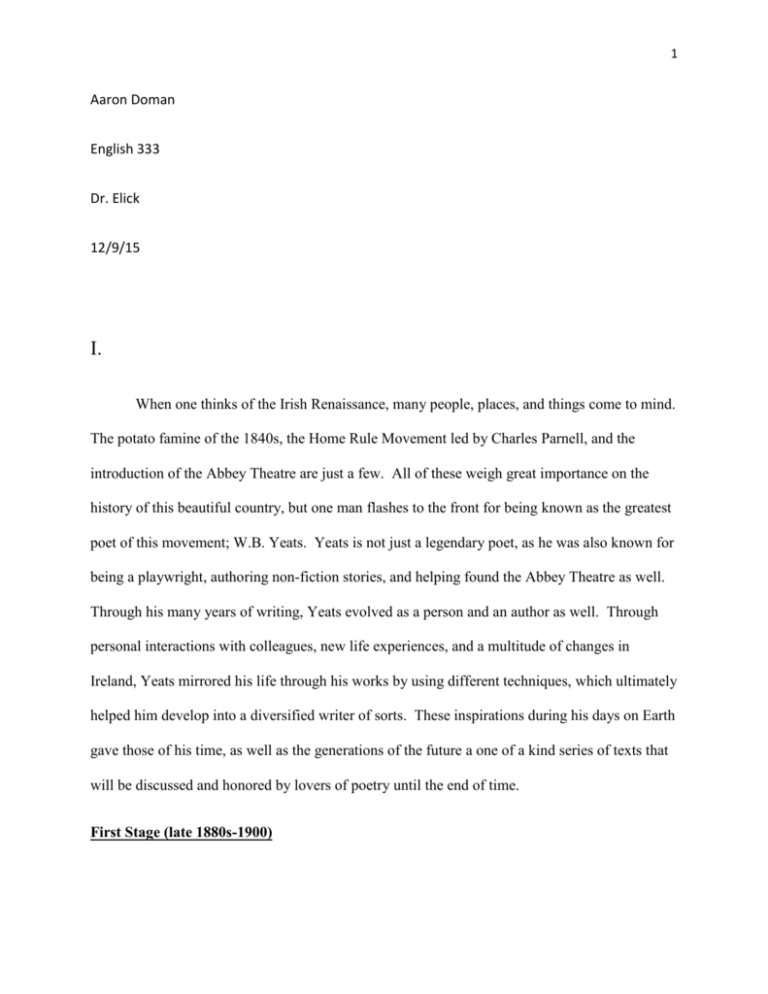
1 Aaron Doman English 333 Dr. Elick 12/9/15 I. When one thinks of the Irish Renaissance, many people, places, and things come to mind. The potato famine of the 1840s, the Home Rule Movement led by Charles Parnell, and the introduction of the Abbey Theatre are just a few. All of these weigh great importance on the history of this beautiful country, but one man flashes to the front for being known as the greatest poet of this movement; W.B. Yeats. Yeats is not just a legendary poet, as he was also known for being a playwright, authoring non-fiction stories, and helping found the Abbey Theatre as well. Through his many years of writing, Yeats evolved as a person and an author as well. Through personal interactions with colleagues, new life experiences, and a multitude of changes in Ireland, Yeats mirrored his life through his works by using different techniques, which ultimately helped him develop into a diversified writer of sorts. These inspirations during his days on Earth gave those of his time, as well as the generations of the future a one of a kind series of texts that will be discussed and honored by lovers of poetry until the end of time. First Stage (late 1880s-1900) 2 In Yeats’s first stage of writing, his works seem to be written with a sense of delicacy. They are very elegant and graceful, almost as if they aren’t supposed to be taken literally but more so in a dream-like state. For instance, in “The Stolen Child” publishes by Yeats in 1886, Yeats describes a young boy being drawn in by fairies rather than stay in the world full of struggle and pain that he cannot yet fathom. Yeats’s use of truly poetic language is seen throughout the passage. For example, in stanza 3 he writes: “In pools among the rushes, That scarce could bathe a star, We seek for slumbering trout, And whispering in their ears, Give them unquiet dreams.” He uses this imagery of nature mixed with supernatural themes as he was influenced by English Romanticism and Celtic myth. During this period of his life, Yeats’s biggest inspiration was Maud Gonne, an actress and revolutionary of Ireland. For most of his life, Yeats found himself entranced by Gonne and she became his muse. Although he expressed his love for her many of times, she never felt the same way for him. Second Stage (1900-20) The first time Yeats’s style of writing changed was at the beginning of the twentieth century. His works became less complex and more casual. When reading texts from this period in his life, it is almost as if you can picture him speaking these words to Maud Gonne. In “Adam’s Curse”, he is writing of a conversation between him and Gonne, in which he describes his passion for her and her response. This style is much more literal and direct as he uses quotes in the poem to specify when he and his counterpart were speaking to one another. In this passage, he quotes Gonne as she talks of how women are expected to act and look a certain way in order to be beautiful: “To be born woman is to know, Although they do not talk of it at school, 3 That we must labour to be beautiful.” She is communicating the fact that it is hard work for females to look the way that they do. In his response, Yeats tries to get across how beautiful he thinks she is and that even though she may weather and ages in the years to come, he will still find her as flawless as ever. In this stage he also becomes more prideful of Ireland and depicts this through nationalistic poems such as Easter 1916, referring to the Easter Rising. At this point in time Yeats is also working at the Abbey Theatre and is influenced by Lady Gregory, who founded the Theatre alongside him. Third Stage (1920-30) The third stage of writing in Yeats’s career falls in the 1920s. He is now married to Georgia Hyde-Lees, and she becomes an influence in his writing. That being said, Yeats was still madly in love with Maud Gonne and she continues to be a source of his written works. Transitioning from a simpler style, Yeats’s texts seem to do a 180 in that aspect. His language is much more strenuous on the audience, and almost demanding to an extent. One can’t simply read through a poem from this stage one single time and expect to comprehend his intentions fully. He still uses a great deal of symbolism in his texts during these years, and he does so with mastery that can’t be matched. His works of this time tend to lie more with the longing to understand the world, mainly through complex contradictions such as age vs youth, and wisdom vs madness. He discusses these paradoxes in his works without actually coming to conclusions about them. In “Leda and the Swan”, Yeats is retelling the ancient Greek myth of a woman being raped by Zeus, who has taken the form of a swan. In this depiction, Yeats uses a multitude 4 of powerful descriptions, and it’s as if he is attempting to channel the emotions that Leda must have been experiencing to describe this horrid story. Fourth Stage (1930-39) The fourth and final stage of Yeats’s writing reveals a drastic change in his style. Yeats is now in his later years and bases his works more off of ballads than in the past. He wants to memorialize the time he has spent and show that aged things should be commemorated as much as innovations. Such as in “The Circus Animal’s Desertion”, as he uses the terms “old” and “vain’ repeatedly almost as to allude that the two go hand in hand. This trend of elder subjects is also apparent in “Crazy Jane Talks with the bishop.” This poem is much duller than those in the past, and his last few works are transparent unto his old age. There is just a lot less going on in his life during this stage, and less influences to help inspire like in the first sixty couple years of his life. Yeats showed his true self in his writing and deserves recognition to the fact that he didn’t write what people wanted to hear. Rather, he wrote in a way that reflected his life at that point, like a snapshot to what he was experiencing at that moment. II. A Portrait of the Artist as a Young Man was the first novel written by James Joyce. This is a coming of age story about Stephen Dedalus, a young Irishman who discovers who he is and wants to be through experiences in education, relationships, and religion. This book is indeed a Bildungsroman, as he struggles to realize that the way he has been raised may not be the right 5 path for him to continue to take. Raised Catholic, there were a lot of rules and restrictions for Stephen to abide by. Although he strives to be righteous in his faith, he continuously falls short and feels awful for his misconduct. He finally brings himself to the fact that he needs to move on from his past and become his own person. The very first paragraph of the book is very important to the story, even though it may not seem that way at first glance. It starts off by Stephen recalling the words to a story that his father tells him as a child. The story is of a moocow and a young lad by the name of baby tuckoo. As he is remembering this story, Stephen compares himself to the young boy in the children’s story. From the very beginning of the book, even as a small child, Stephen is trying to uncover exactly who he is. He has little to go off of since he is still very young, but his answer resides in something that his father says. Instead of thinking for himself and coming up with his own internal observations, he is basing his thoughts off of what other people are telling him. Granted, this example is much more light-hearted than as the book goes on; however, the message behind this passage is vital to Stephen growing up and thinking as his own person. Over analyzation becomes a prominent theme in this novel, as in every situation Stephen finds himself in, he begins to question it. When he first starts studying geography in his flyleaf, he thinks about where he is on a larger scale. He reads what he has written, “Stephen Dedalus, Class of Elements, Clongowes, Wood College, Sallins, County, Kildare, Ireland, Europe, The World, and The Universe.” He then thought of God, and how God’s name is God. He thought of people praying in France and using the French term for God, and how God knew that they were French. Stephen tried to enlighten himself through these thoughts and it is easily seen that although he was struggling with whom he is, Stephen will continue to try and make connections 6 in his life until something makes sense and sticks. As he gets older, Stephen encounters many things that shape him as a person and help him develop a personal identity. This novel is also known as a Kűnstlerroman, which refers to a story in which an artist matures into his or her own. Stephen longs to be an artist, and from that passage in his flyleaf in is apparent that he wants to write. He reads the passage backwards and thinks of how it isn’t a poem. Many of people wouldn’t have read it upside down, let alone try and compare it to poetry. But Stephen is one of a kind, and it is obvious that he wants more than the average guy. As he attends the university and becomes close friends with Cranly, Stephen finally begins to realize exactly who he wants to be as a writer. I think the title of this novel is perfect, as it accurately describes the story. Portraits usually only refer to the head and shoulders, just as this story is only showing a certain time in Stephen’s life. He is indeed a young man, and longing to be an artist in his own way. This work shows the most important time in his life, as he finds himself and realizes wishes to do with the remainder of his life. III. Spirituality, superstition, and religion all play a vital role in Irish literature. Throughout the semester we have read and seen many of stories that rely on the importance of one or more of these categories. Superstition has been around since ancient times, and is present in many folklore tales. W.B. Yeats authored two short plays that both have supernatural occurrences that cannot be explained. In Cathleen Ni Houlihan, an Irish family is preparing for the upcoming wedding between their eldest son and his fiancé. Meanwhile, an older woman approaches and begins a conversation with the family about how her land was stolen and that she needs someone to fight for her. Michael, engaged to be married, is intrigued and follows her out the door. 7 When the youngest son, Patrick, comes in from outside, he says that Michael was walking with a young, vibrant woman. In the beginning of the play, Patrick sees the woman as old but by the end she has transformed into a beautiful young woman. This aged woman is supposed to be depiction of Ireland, showing how over the years land has been lost and that the men need to stand up and fight for their homeland. Michael was enticed by the woman’s beauty, which is meant to be hopeful for the future of Ireland. If enough young men join the war and battle for what has been lost, Ireland can possibly become the beautiful, lush country that it once was. Another play written by Yeats that references superstition is Purgatory. In this play, an older father and his son are speaking in front of a ruined home. The old man talks of all the important people that have once lived in this house, and how it has been full of struggle and remorse. In the background, the window of the house is lighting up with past scenes of the strife and turmoil that once took place there. The boy sees this and is dumbfounded, as it seems impossible to comprehend. This play brings these horrible memories to light in a mythical illusion. Into the West is a children/family Irish film about a white horse. Two young boys come across this creature and are amazed from the first encounter. Little did they know that this isn’t an ordinary animal and it has come from the land of eternal youth and is magical. The young boy is the only one able to mount and ride the horse, as it is very find of the young boys. The horse seems as if it can sense what the boys are thinking and races across Ireland with the two lads. This type of superstition is more warmhearted than other examples in Irish literature, but still keeps the underlying theme that nothing is impossible. Grace is a short story written by James Joyce about a man who has lost his faith. Religion is of utmost importance to many in Ireland, and is present throughout tons of literature. In this story, Mr. Power finds himself drunk once again and making a fool of himself in a public 8 venue. Afterwards, his friends mention to him about an opportunity to rekindle his faith and get back on track. Although he reluctantly agrees, it is easy to see that he has little interest in becoming more religious. He gets upset about candles and is in an obvious state of paralysis even though he knows a change is needed. The story ends soon after the priest gives his sermon. Mr. Power speaks of how he is going to set his accounts right, but it has a fake feel as if it is all for show, and that he is just saying what everyone wants to hear. This story attempts to be as realistic as possible to Irish life. In many stories everything ends happily ever after, but in this passage along with the rest of Dubliners, James Joyce portrays Irish life as it should be. People make mistakes and fall short, but it is by grace that we are saved.
